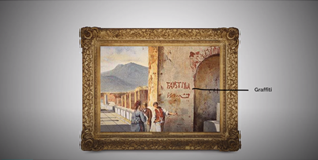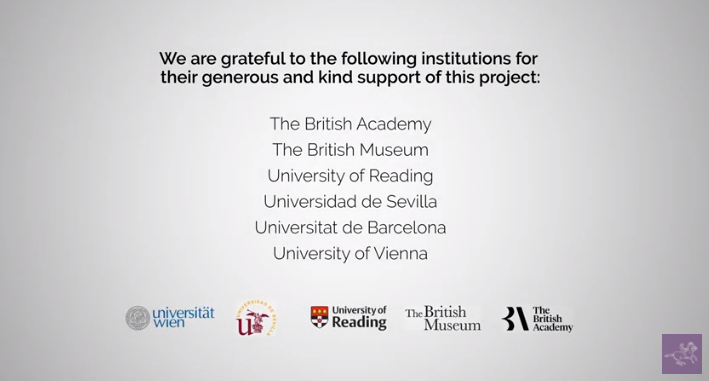Interviewees: Prof. Peter Kruschwitz, Dr. María Limón & Prof Xavier Espluga. Interviewer: Bunny Waring
Date: 30th April 2021.
Today the Classics Department of Reading is delighted to announce the release of a special video called What Can a Dog Called Margarita Teach us About Ancient Rome? In this video Prof. Peter Kruschwitz (University of Vienna), Prof. Xavier Espluga (University of Barcelona) and Dr. María Limón (University of Seville) discuss the lettered world of ancient Rome and how ancient peoples interacted with the world around them. The video was filmed, directed and edited by James Rattee (https://vimeo.com/jamesrattee/videos) and includes digital footage from Prof. Matthew Nicholls’ Virtual Rome model.
Today we invited Peter, María and Xavier to discuss with us the motivations and methods of making this video and what is next for this interesting project on ancient inscriptions.
INTERVIEW
Bunny Waring (BW): Good Morning All. Thank you for joining us this morning to talk about your collaborative piece What Can a Dog Called Margarita Teach us About Ancient Rome? The Classics Department are very excited to share this work and we wondered if you could explain a little bit about your motivations for this project?
 Thank you so much for this – it’s great for us to be back for a little while, albeit virtually. All three of us share the same passion: our enthusiasm for Roman inscriptions, especially inscriptions composed in verse. To us, those inscriptions are not just stones or pieces of metal that happen to have some poetry inscribed on them. They are carriers of art. They are visible, tangible manifestations of a universal artistic practice of Roman times, spanning the empire across time and space, with thousands of examples surviving to the present day.
Thank you so much for this – it’s great for us to be back for a little while, albeit virtually. All three of us share the same passion: our enthusiasm for Roman inscriptions, especially inscriptions composed in verse. To us, those inscriptions are not just stones or pieces of metal that happen to have some poetry inscribed on them. They are carriers of art. They are visible, tangible manifestations of a universal artistic practice of Roman times, spanning the empire across time and space, with thousands of examples surviving to the present day.

This art was produced by individuals from all runs of life, and it was produced in the city of Rome just as much as it can be found at Hadrian’s Wall, the shores of the Black Sea, or in the Roman settlement of North Africa. We can relate to these individuals very easily because they’re not just some remote elite: they are people with everyday occupations, everyday hopes and worries, everyday problems. Like (most of) us – the other 99%, so to speak, far away from the palaces and lives of the elite. What is more, these individuals inhabited the very spaces, geographically and socially, that we still inhabit today, along with all their challenges.

It’s neighbourhood poetry, it’s communal art. And it gives us the most direct, emotionally moving, and instructive access to the world(s) of ancient Rome.
Of course, we know how we ourselves, especially in an academic context, interact and engage with Roman inscribed material remains. But how did they do it? We were curious to find out! And then we got very lucky: the British Academy gave María the opportunity to get our joint research going, first through its visiting fellowship scheme, then through additional funding for this video. We are so grateful for their support, and we hope that this video will both repay them for their trust in our research and appeal and communicate to wide audiences just what incredible, valuable material we study in our desire better to understand the Roman world and its diverse cultures.
BW: How exciting to work on such an interesting topic! So I’m eager to know: why did you choose this particular inscription?
 We wanted to make a number of strong, important points. About the way in which we perceive, in which we encounter the Roman world. About the way the ancient world is presented to us in museums, archives, exhibitions, and books. And we want to do so while racing a wide audience because what we have to say and offer is relevant to so many different audiences.
We wanted to make a number of strong, important points. About the way in which we perceive, in which we encounter the Roman world. About the way the ancient world is presented to us in museums, archives, exhibitions, and books. And we want to do so while racing a wide audience because what we have to say and offer is relevant to so many different audiences.
 We want to enthuse new generations with our passion for Roman history, for poetry, for epigraphy. We want to give teachers the opportunity to expand the canon of teaching through the inclusion of poetry that students can easily relate to. We want to invite museums, collections, and policymakers to rethink their approach to the way in which these incredibly exciting, talking objects from the ancient world are displayed. What better way to achieve this than to choose a text that expresses, in such beautiful words, the grief of pet owners – whose faithful companion had died. We feel we all can relate to that, and we feel that this text alone opens up so many new ways of thinking about the Roman world and the people who “were” the Romans, than the ever-same repertoire of classical authors.
We want to enthuse new generations with our passion for Roman history, for poetry, for epigraphy. We want to give teachers the opportunity to expand the canon of teaching through the inclusion of poetry that students can easily relate to. We want to invite museums, collections, and policymakers to rethink their approach to the way in which these incredibly exciting, talking objects from the ancient world are displayed. What better way to achieve this than to choose a text that expresses, in such beautiful words, the grief of pet owners – whose faithful companion had died. We feel we all can relate to that, and we feel that this text alone opens up so many new ways of thinking about the Roman world and the people who “were” the Romans, than the ever-same repertoire of classical authors.
BW: There must be a lot of interesting stories out there?

There are several thousand inscribed poems surviving from across the Roman world. You find anything, from obscene graffiti on the walls of Pompeii, to epitaphs on funerary monuments, 110-lines long and erected in the desert of Roman North Africa. You find beautiful, outrageous, hilarious, thought-provoking pieces, but, of course, also the banal and uninspired. How else could it be: writing short(ish) poems was a shared pastime across the ancient world, and the pieces are just as varied as their authors – men, women, children. If you would like to see further examples, you may explore them in an easily accessible format here and here. The material truly is a hidden treasure waiting for its discovery.
BW: What was it like recording this piece? Would you recommend the process to others?
 Haha, oh dear! Well… none of us are natural-born entertainers. We all were terrified and at first, we hated to see our faces and hear our recorded voices. But James Rattee, the producer and creative mind behind our video, did an incredible job to make us feel at ease, to make us look smart (within the limitations that we were painfully aware of), and make the video appealing to such a wide range of audiences.
Haha, oh dear! Well… none of us are natural-born entertainers. We all were terrified and at first, we hated to see our faces and hear our recorded voices. But James Rattee, the producer and creative mind behind our video, did an incredible job to make us feel at ease, to make us look smart (within the limitations that we were painfully aware of), and make the video appealing to such a wide range of audiences.  We hope that putting this video out there will make it available for generations to come – for pupils, teachers, academics, cultural managers, policy makers: it should entertain and be useful at the same time! It’s genuinely a piece of art.
We hope that putting this video out there will make it available for generations to come – for pupils, teachers, academics, cultural managers, policy makers: it should entertain and be useful at the same time! It’s genuinely a piece of art.
BW: Well we all certainly agree with that, here in Classics at Reading University! Excellent work! Finally then, what is in store next for your project?
We want to do more. We want to reach out to schools, to those who design curricula, design teaching in schools and at university, to show them the potential and possibilities. And we want to transform the way in which inscriptions are presented and utilised in museums – there is so much potential wasted.

We are making first steps. But there’s much more work to be done. So, if you are interested, please do get in touch with us, and we will explore the potential for collaboration with you! And as we are still thinking about reaching larger audiences and improving educational materials we would be deeply grateful if viewers, students and teachers, from all over the world would send us their feedback, even in an informal way. And by all means do feel free to send us any kind of questions regarding how Roman communicate their feelings, emotions, fears, and concerns through their inscriptions.



